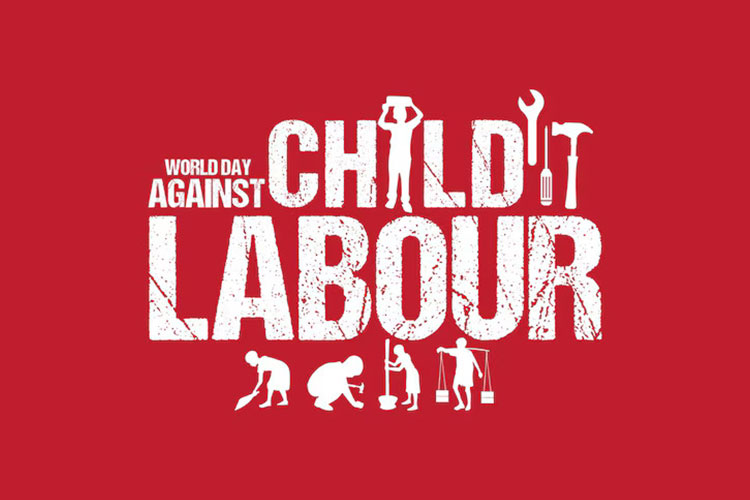International Child Labour Day

International Child Labour Day: A Call for Action against Child Exploitation
Introduction:
Child labor is a serious problem worldwide. Today, millions of children around the world are still subjected to exploitative manual labor. The International Labour Organization (ILO) joins with ILO members and partners around the world to celebrate International Child Labour Day to raise awareness about and eliminate child labor. In India too, due to illiteracy and economic inequality, many children are subjected to child labor, which continues to deprive them of their childhood, education, and basic human rights. However, in recent years, much progress has been made in reducing child labor worldwide. The main objective of observing this day is to address the root causes of child labor so as to create a future where no child is forced into labor against their will. But to realize this objective, governments, organizations, and individuals must work together to eliminate child labor by establishing strong regulations, supporting educational programs, and promoting ethical business practices.
Table of Contents:
-
What is child labour?
-
Background
-
Causes of Child Labour
-
Impact of Child Labour
-
Global Efforts to End Child Labour
-
How Can We Contribute to Ending Child Labour?
-
What is Child labor:
Work performed by children that is mentally, physically, socially, or morally dangerous and harmful is classified as child labor. It often interferes with their education and restricts their right to development. However, work that does not affect their health and personal development or disrupt their education is generally considered positive. According to the International Labor Organization (ILO), around 160 million children worldwide are engaged in child labor, most of which is involved in hazardous work.
-
Background:
-
In 2002, the International Labour Organization (ILO) established the first World Day against Child Labour to review and rethink our strategies for the elimination of child labor.
-
Since then, 12 June has been observed every year as the World Child Labor Day.
-
The UN General Assembly, recognizing the prevalence of child labor, unanimously adopted a resolution declaring 2021 the International Year for the Elimination of Child Labor and tasked the ILO with implementing it.
-
According to the ILO, around 100 million girls and boys around the world are involved in work that deprives them of adequate education, health, leisure, and basic freedoms.
-
More than half of these children are exposed to the worst forms of labor, including work in hazardous environments, illegal activities such as slavery, drug trafficking, and prostitution, or involvement in armed conflict.
-
Causes of Child Labour:
Child labor is a complex problem with multiple underlying causes, which include—
-
Poverty.
-
Illiteracy.
-
Cultural norms.
-
Weak laws.
-
The global demand for cheap labor.
-
Impact of Child Labour:
Child labour brings serious harm to children's futures and overall well-being:
-
Health Hazards: Exposure to hazardous work environments puts children at risk of injuries, chronic illnesses, and harmful chemicals that can affect them long-term.
-
Educational Setbacks: A large number of child labourers miss out on schooling or are forced to quit early, which greatly reduces their future possibilities.
-
Psychological Effects: Being subjected to labour at a young age can cause emotional distress, low self-worth, and ongoing psychological trauma.
-
Cycle of Poverty: Beginning work too early often traps children in poorly paid jobs for life, continuing the vicious cycle of poverty.
-
Global Efforts to End Child Labour:
Several international organizations and initiatives are working to eliminate child labor:
-
International Labor Organization (ILO): It promotes conventions such as the Minimum Age Convention (Convention No. 138) and the Worst Forms of Child Labor (Convention No. 182).
-
United Nations (UN): End child labor by 2025 under Sustainable Development Goals (SDGs) Target 8.7.
-
UNICEF: It provides education and protection to vulnerable children worldwide.
-
Government policies: Many countries have implemented laws to end child labor and promote compulsory education.
-
How Can We Contribute to Ending Child Labour?
-
Support ethical brands by choosing products from companies that follow fair labor practices.
-
Use social media and community platforms to educate everyone about the issue of child labor.
-
Support strict anti-child labor laws and initiatives.
-
Support and help NGOs that provide education to underprivileged children or work as volunteers.
-
Report child exploitation to authorities or relevant organizations immediately if you witness it.
Conclusion:
International Child Labour Day goes beyond raising awareness – it is a powerful call to action. Individuals, governments and organizations must come together to combat child labour and ensure a world where all children grow up in nurturing and safe environments. By tackling the root causes and strengthening law enforcement agencies, we can move towards a future where no child loses their childhood to forced labour.
FAQs:
1. Whose birthday is celebrated as Children's Day in India?
-
November 14, the birth anniversary of the first Indian Prime Minister Pandit Jawaharlal Nehru, is celebrated as Children's Day in India.
2. How many children are involved in child labor?
-
Globally, around 168 million children aged 5-17 are involved in child labor.
3. Who started World Child Labour Day?
-
In 2002, the International Labour Organization (ILO) introduced World Child Labour Day.